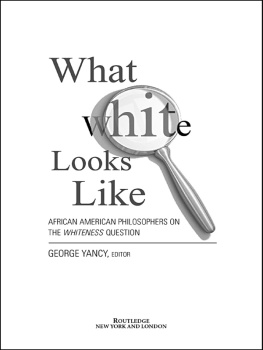BLACK WOMEN AND WHITE WOMEN IN THE PROFESSIONS
PERSPECTIVES ON GENDER
Editorial Board:
Myra Marx Ferree, University of Connecticut
Virginia Sapiro, University of Wisconsin-Madison
Kay Deaux, CUNY Graduate School and University Center
Pleasure, Power, and Technology: Some Tales of Gender, Engineering, and the Cooperative Workplace
Sally Hacker
Black Feminist Thought: Knowledge, Consciousness, and the Politics of Empowerment
Patricia Hill Collins
Understanding Sexual Violence: A Study of Convicted Rapists
Diana Scully
Feminism and the Womens Movement: Dynamics of Change in Social Movement Ideology and Activism
Barbara Ryan
Maid in the U.S.A.
Mary Romero
BLACK WOMEN AND WHITE WOMEN IN THE PROFESSIONS
OCCUPATIONAL SEGREGATION BY RACE AND GENDER, 19601980
Natalie J. Sokoloff
Published 1992 by
Routiedge,
711 Third Avenue,
New York, NY 10017
Published in Great Britain by
Routiedge
2 Park Square, Milton Park,
Abingdon, Oxon 0X14 4RN
Routiedge is an imprint of the Taylor & Francis Group, an informa business
Copyright 1992 by Natalie J. Sokoloff
All rights reserved. No part of this book may be reprinted or reproduced or utilized in any form or by any electronic, mechanical or other means, now known or hereafter invented, including photocopying and recording, or in any information storage or retrieval system, without permission in writing from the publishers.
Library of Congress Cataloging-in-Publication Data
Sokoloff, Natalie J.
Black women and white women in the professions: occupational segregation by race and gender, 1960-1980. / Natalie J. Sokoloff.
p. cm.(Perspectives on gender)
Includes bibliographical references and index.
ISBN 0-415-90608-3. ISBN 0-415-90609-1 (pbk.)
1. Women in the professionsUnited States. 2. Minority women in the professionsUnited States. 3. Afro-Americans in the professions. 4. Professional employeesUnited States. 5. Discrimination in employmentUnited States. I. Title. II. Series: Perspectives on gender (New York, N.Y.)
HD6054.2.U6S65 1992
CIP
British Library Cataloguing in Publication Data Available on Request
ISBN 0-415-90608-3 hb
ISBN 0-415-90609-1 pb
For my son,
Joshua Mark Pincus-Sokoloff, and his generation: through struggle, change is always possible
I was recently talking to a white male student about his prospects for employment in the future. I think affirmative action is okay, he told me, but is there any room in the labor market for me? From this students perspective, white men were being forced to take a back seat to minorities and women in the labor market. Occupational data are at odds with his perspective, but the numbers on the spreadsheets seemed distant from his plight. I asked the young man to clear his calendar and spend some time with me, stopping at a university print shop, a television station, a newspaper, a library, a bank. The ethnic composition varied from place to place, but the faces of those in authority were almost uniformly white. At the end of our three-hour jaunt, my student seemed somewhat reassured that people of color were not going to dominate the labor market any time soon.
It is easy to rail against the myth that white men are being elbowed out of the best jobs in the labor market, or to bristle when President Bush calls a tepid civil rights measure a quota bill. It takes a bit more work to decompose the myths and explain how the labor market is changing. Natalie Sokoloff has done the work of decomposition in her book, Black Women and White Women in the Professions.
Most of those who write about race and gender in the labor market compare black and white women to each other. Sokoloff undertakes the painstaking task of comparing these women to each other, but also to black men and white men, by both general and detailed occupational categories. By undertaking this detail of analysis, Sokoloff brings forth the facts behind the headlines. Writing that black women in no way reached parity with black men in either group of the professions, she debunks the myth of the twofer (the notion that black women are double-counted in affirmative action statistics, as black and as female, providing measurement conscious affirmative action officers with two for the price of one) that has divisively defined much of the discourse on race and progress in the African American community.
The twofer myth is not the only one that gets an argument from Sokoloff. In her chapter on white men in the professions (aptly titled, The More Things Change, The More They Stay the Same), she responds directly to the notion of white male displacement by noting that white men continued to be the overwhelming majority in the most desirable and visible of the professions. White men lost some ground, says Sokoloff, but only in moderate status professions. Meanwhile, white male overrepresentation in the elite male professions increased from moderate to severe.
Sokoloff produces similar, myth-shattering findings about the status of white women in the labor market, showing that white women remain more concentrated in the female professions, with fewer than one percent of all employed white women represented in the elite male professions. Sokoloffs findings might seem incredible, given all the hype that weve heard about white women taking over the typically male professions. But after having been bombarded with the 1991 picture of an all-white-male Senate Judiciary Committee, this work becomes all the more compelling.
Although Sokoloffs analysis stops in 1980, it is interesting to think about her findings in the context of the 19801990 decade. Socioeconomic data suggest that the status of working people, especially African Americans, has deteriorated in the 19801990 period. Wages bifurcated in the 1980s and the amount of black poverty grew to the point where one in three African Americans (and the majority of black children) live in poverty. Even among the professionals that Sokoloff discusses, there was significant job insecurity. This insecurity combined with the concept of glass ceilings, perhaps explains the dramatic increase in the number of self-employed workers in the late 1980s.
How do we measure the status of these new independent professionals, and how do we quantify the fact that many will operate at the periphery of the economic mainstream, with influence diminished by their distance from corporate employment? Does it matter if African American and women professionals are more likely to be self-employed? How are social policy issues affected by this distribution? Sokoloff does not answer those questions, but her framework provides a useful basis for analysis.
Similarly, and in the context of comparison, it is interesting to note that the foreign-born population increased by more than 8 million in the last decade. One in twelve of those counted in the 1990 Census were foreign born. Some have called the 1980s the decade of the immigrant and lauded our countrys ability to absorb new people. In the same sense that Sokoloff asks if white men have been displaced by women and minorities, one might ask if American workers have been displaced by immigrants, and if so in which occupations.







